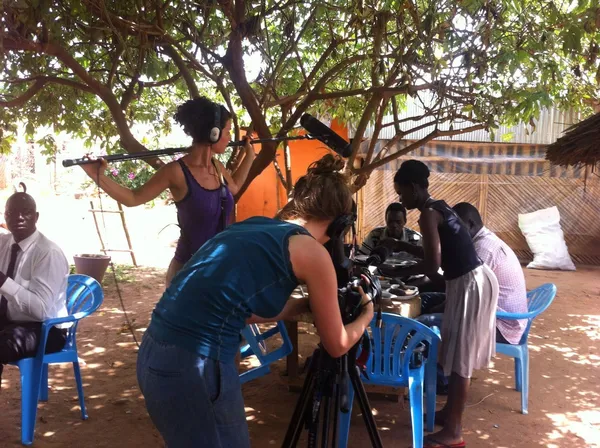 |
| Ariadne Asimakopoulos and Maartje Wegdam filming No Place For A Rebel |
One of the highlights of this year’s Scottish Mental Health Arts Festival has been Ariadne Asimakopoulos and Maartje Wegdam’s documentary No Place For A Rebel, which explores the issues around former child soldiers returning from the Lord’s Resistance Army and trying to rebuild their lives as civilians. History and politics mingle with observations on the social challenges involved and the mental health problems suffered by the returnees, all centred on the personal story of 26 year old Opono Opondo. Just a day after it won Best Feature at the Justice Film Festival, the two directors Skyped in from a café in the Netherlands to discuss the film.
“To introduce ourselves, we knew each other before we started making the film,” says Maartje. “We’ve been friends since childhood, actually. Ariadne studied Conflict Studies and my background is in documentary film. Ariadne’s thesis was on the subject matter of the film, different perceptions of victim/perpetrators in northern Uganda, people who come back from the LRA. So she’d been in northern Uganda for months already and she had this network and body of research and all these contacts, and then I read her thesis and we discussed the questions that the research raised, and then we thought, ‘Shall we just see if we can develop this work into a documentary film?’ So that was how it started and we decided to go to Uganda together to see if we could find a character who would embody all these different questions and go on this journey of finding a new place back home.
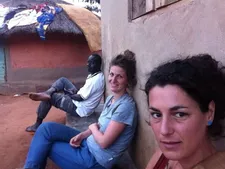 |
| Relaxing in the village |
“After a year and a half of research we found Opono, who had got back from the LRA just a couple of months before. To us he seemed immediately like a person we wanted to follow, also because he was just at the point of returning and really trying to build up this life for himself. He was willing to participate and to open up to us for a long period of time, and as you saw in the film he’s very eloquent and very reflective of his own position, so then we knew that this would be the person to follow.”
People elsewhere in the world tend to be more sympathetic to child soldiers when they’re young, I note. Did they see it as an extra challenge to focus on an older person?
“Actually, yesterday I spoke to somebody who said the opposite,” says Ariadne. “He said ‘I cannot imagine, after seeing this film, that this guy was in the bush for all those years, or what he has done but, at the same time, when I think of the images that I’ve seen before of these kind of conflicts or child soldiers then I can think of what he’s done, but it’s difficult to imagine these two sides of someone in this person.’”
Did they interview many other people before deciding on Opono as their main subject?
“Yes,” says Maartje. “Before we found Opono, in the year and a half we were doing research, we worked closely together with Victor, who was a researcher and translator to us – I think without him we definitely couldn’t have done it – and he knows many of those former child soldiers in this community. So we spoke with dozens. It’s not hard to find them because there are many who came back, but it was a big challenge to find someone who was young when he was abducted and rose through the ranks. We didn’t want to interview someone who was still a teenager – we wanted someone who had these different sides within his own identity, and who grew up to have responsibilities and maybe also gave orders. So in order to do that you have to find someone who was there for a long time and then someone who has just returned. And then we found people that were either shy or felt very uncomfortable, or feared opening up on these very personal and stigmatising issues. In the end, he [Opono] just stuck with us.”
What kind of effect does the experience of being a child soldier have on people psychologically?
“I think it plays a very important role in someone’s life but often it’s hidden, what people are experiencing within themselves: their memories or dreams they might have or just thoughts,” says Ariadne. “We are talking about people who, for example, when they see meat, they remember what happened in the bush, or when they hear specific sounds, it reminds them, but it’s not very common to speak about these problems in the community where they live. Also, of course, it’s difficult to film these things because it’s not always visible, because it happens within someone, but it affects, in this case, Opono’s life to a large extent and on a daily basis. So that is one of the things that we tried to include, and we asked him to reflect back on what had happened and include this in between the daily activities that he’s doing trying to find his new life, so we go from daily practical activities to thoughts and memories, and by that we tried to show what he’s thinking about.”
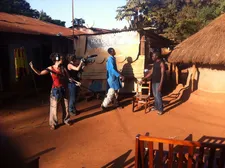 |
| On set in Gulu |
“The film is showing in Scotland and Uganda is quite far away so you might think ‘Why is it important for someone in Scotland to see about mental trauma in Uganda?’” adds Maartje. “But I think the issues that are reflected in the film are very universal. They are not limited to a Ugandan context. I think it reflects the difficulty of people who return to their communities from armed conflict and try to build up their lives. I think the mental trauma is often taboo and hidden, not only in Uganda but in many places around the world, and I think it’s important for people to think about reintegration and connecting with people who came back. It’s a two way street. Some people may get more aware of what a person is going through and ask the question ‘What should be done?’ or ‘What can I do?’ to advance these processes of reintegration.”
Is there much help available for the returnees in Uganda?
“There used to be more organisations working on the reintegration of former LRA combatants,” says Ariadne. “They used to do trauma counselling and provide vocational training skills and put them through school, but what we see now is that many of those organisations faced difficulties in terms of getting funding because the regions is not so much on the agenda of international donors any more. Also, the government is absent in some ways, so right now there are not so many organisations working on this issue.
“I think generally, trauma counselling or psycho-social counselling, the programmes that existed were often limited and short term. For example, those people who came back from the bush, they’d get some weeks of counselling, but when you’ve been away for 16 years that’s very limited and might not be enough. Also, what kind of trauma counselling is suitable in this context, for these people in these communities? When international organisations go there and they use the same therapies that they use here in the Netherlands or Glasgow, it might be difficult to treat people for the same issues. For example, when they talk about the spiritual world, beliefs in possession by spirits, then you need to take a different approach.”
Are people afraid that the LRA might return?
“Right now, the LRA has shrunk and is not present in Uganda any more,” says Maartje. “They are mostly in surrounding countries, but they are still active and still recruiting children from these neighbouring countries. There used to be a mission that the US was also part of, called the hunt for Joseph Kony, to capture Kony and really end the LRA, and only a few months ago the mission was aborted, partly due to funding problems. The conclusion was that because there are only a few hundred of its soldiers left the LRA will no longer be a threat to the region, but on the other hand, Kony has a lot of sons, and these sons are also having children, and these are people that have grown up in the LRA, they’ve never actually lived outside it. So it’s really hard to say, if they would come out, if they would manage in a civil society; or, in future, if no-one is going after them, if they would get stronger in ranks and maybe form new goals. So it’s hard to predict.”
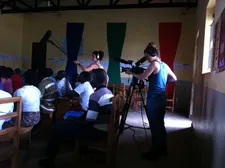 |
| Filming in Gulu |
“The chances are very small that the LRA comes back to the region and does the same again, also because the Ugandan army is very strong,” Ariadne adds. “But the issue is that the grievances and the root causes of this previous conflict are not addressed, which means that in the future another group, or maybe the same people, could take up arms again. If you really want to look to the future and have a sustainable peace process then these deep rooted causes need to be addressed first. But the LRA cannot just cross into Uganda again and start abducting people.
“But as we see in South Sudan, these are not stable situations, and South Sudan is only 90 kilometres away from Gulu, where we filmed, so in that sense it is a volatile situation.”
The film includes some criticism of the Ugandan government, I note, wondering how they will react to that.
“Yeah, we also wonder how they will react!” Ariadne exclaims. “We actually have not shown it in parliament so far, so we’ve just filmed it by ourselves and we’ve always been in touch with local governments that we were making a film about northern Uganda and the aftermath of the conflict, but they had no say in the contents of the film, of course. I think that the criticism that we have of the government is not something that has never been said before.
“We were there in 2013 and there was a petition that was brought to parliament by all kinds of organisations that were in some ways victimised by the conflict, among them formerly abducted persons, and there was a motion for reparations and more interventions by the government in the aftermath and in the reintegration process. The motion was adopted unanimously. So there is a recognition that there are gaps in the interventions but, on the other hand, we returned in 2017 to show the film to our main characters and we also showed it to organisations, and we were asking if they had noticed anything of the implementation of that notion and that so far hadn’t really happened; at least, we didn’t hear that that happened. So there seems to be some gap between recognising need and actually acting on it.”
Has Opono had the chance to see it?
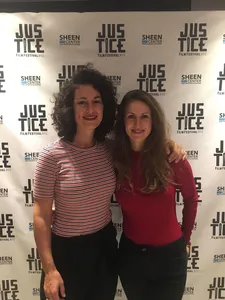 |
| Ariadne Asimakopoulos and Maartje Wegdam |
“Yes, when we came back to Uganda and screened it, coincidentally Opono had returned to Uganda and was in Gulu at the exact period when we were there, so we were able to meet him and show him the film and his reaction was really quite positive,” says Maartje. “He found it confronting, of course, and painful to watch himself in a very vulnerable position onscreen, but on the other hand he felt that it reflected his experiences from the time, and he also felt – which was interesting – that, I mean, he’s been in the army now for a year, and he’s had many other experiences, and he really grew in self-confidence and in a sense of strength and belonging, and he really looked healthier too, and stronger, and he felt like he was back into a place of progress. So he said he felt that he was really looking back at something, he was looking at something from the past rather than still being in the same position.”
Ariadne hopes that the film can be useful in educating people. “The people in northern Uganda who lived through the conflict obviously know what has happened to people in the bush, what they were put through, what they were made to do, because they talk about it – they talk to their children, to their neighbours. People were sensitised about this, but at the same time there’s also a taboo on these personal stories or who did what exactly or how people are doing now, like what I said about trauma. This is not something people are used to talking about. So the film can play a role in opening this discussion and it shouldn’t be done, maybe, in a very public way, but it’s possible that it can help people to understand that even after so many years it’s still an issue that people face every day. People still face challenges, the people who went into the LRA, like our main character, and also of course the people around him. In the scene with his family you can see that there’s a lot of pain and there’s a distance between them.
“That’s in northern Uganda. I think in the rest of Uganda it can also be a tool to create understanding or even raise awareness about what has happened in the north, because the way it was written about in the media, it was presented in a very limited way, not so much showing different sides to the conflict. The rebels were the rebels, framed as evil people, crazy people, and even now we see that many people in Kampala don’t really know what the situation is like now in the north, although there hasn’t been war for ten years.”
No Place For A Rebel will be screening at This Human World film festival in Vienna in early December, and will be on theatrical release in the Netherlands from 9 November.
If you would like to screen the film or help support Opono, you can enquire at [email protected].





















